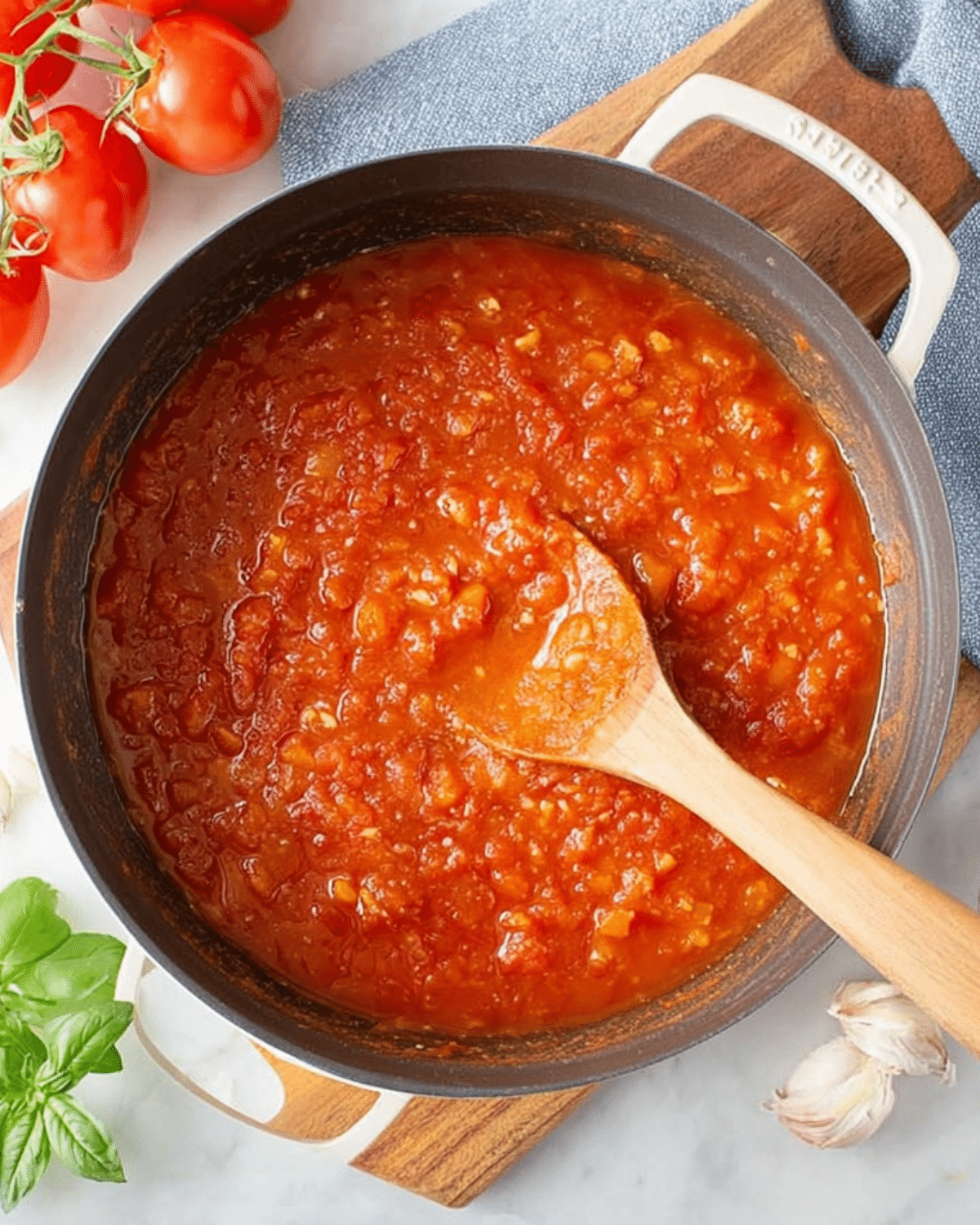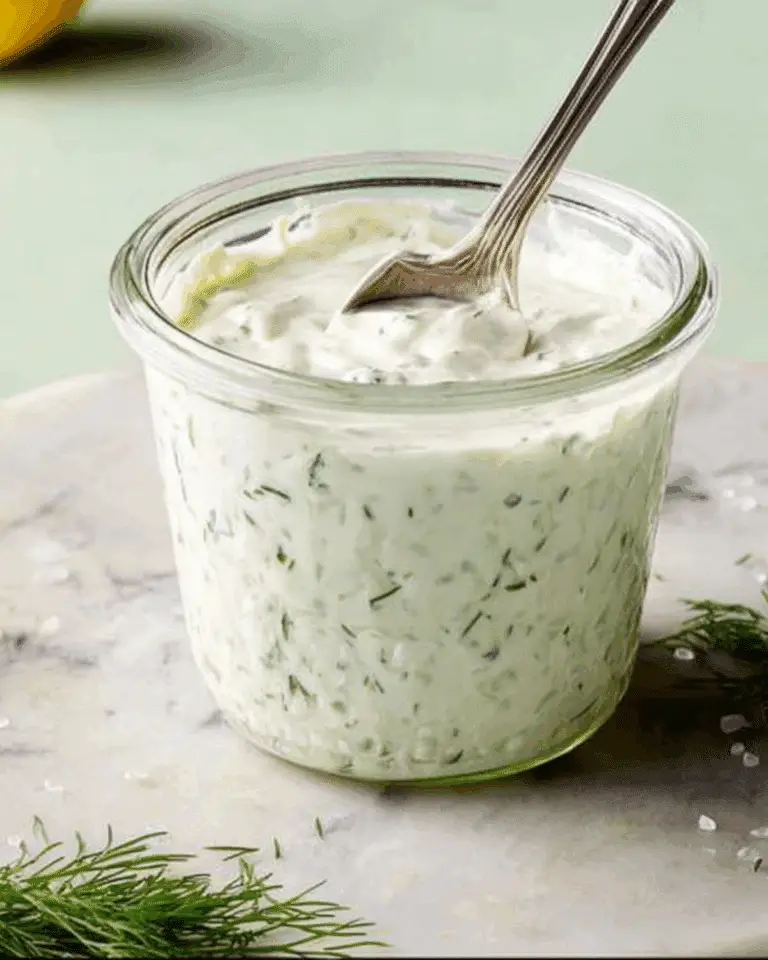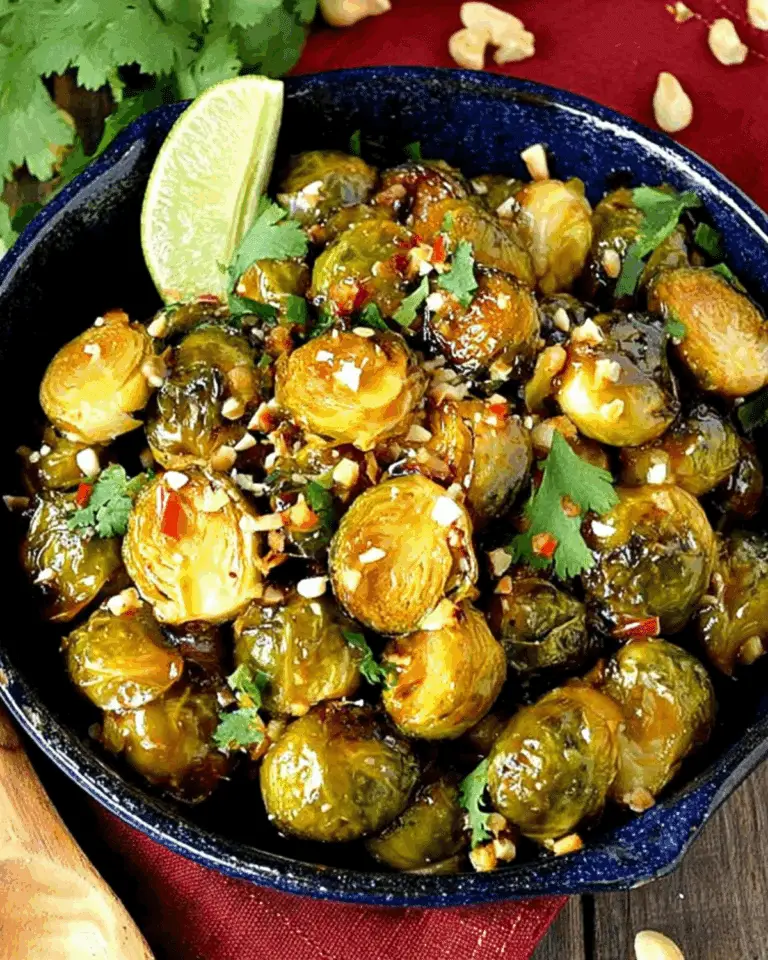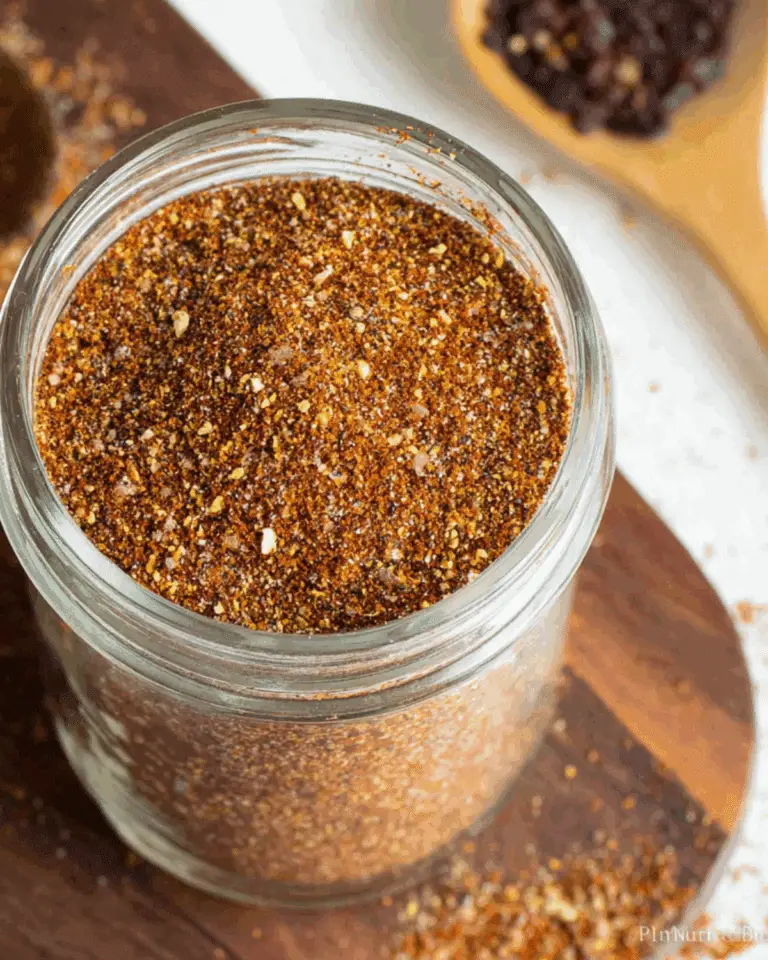Homemade tomato sauce is more than just a kitchen staple—it’s a tradition. Whether you’re using peak-season tomatoes from your garden or a quick batch with pantry staples, nothing compares to the taste of fresh, slow-simmered sauce. It’s healthier, customizable, and packed with flavor that store-bought jars just can’t match. The best part? Making it at home doesn’t have to be complicated. From family pasta dinners to pizza nights, homemade tomato sauce can transform everyday meals into something truly special. Don’t miss our tomato soup with fresh tomatoes if you’re looking for another way to celebrate garden produce.
JUMP TO
Table of Contents
Why Homemade Tomato Sauce is Worth Making
Healthier and Fresher than Store-Bought
Most store-bought sauces are loaded with preservatives, added sugar, and sodium. When you make your own homemade tomato sauce, you control the ingredients. Using fresh tomatoes and simple aromatics like garlic and basil ensures a nutrient-rich sauce without unnecessary additives. Plus, you’ll enjoy the natural sweetness and tang that only fresh produce can deliver.
Budget-Friendly and Family Approved
Cooking your own sauce isn’t just healthier—it’s cheaper. A big batch of fresh tomato sauce can be made for a fraction of the price of jars from the store, and it usually yields more servings. It’s also freezer-friendly, meaning one cooking session can provide multiple meals. Kids and adults alike love it, making it a go-to for family dinners.
Versatile Uses from Pasta to Pizza
Homemade tomato sauce isn’t limited to spaghetti. It’s the perfect base for lasagna, casseroles, soups, and even as a dipping sauce for appetizers. Pizza lovers especially appreciate a rich, flavorful red sauce for homemade crusts. If you want even more dinner inspiration, check out this hearty stuffed pepper casserole that pairs beautifully with a spoonful of tomato sauce.
Essential Ingredients for Fresh Tomato Sauce
Choosing the Right Tomatoes (Roma, San Marzano, Cherry)
The foundation of great homemade tomato sauce is the tomato itself. Roma and San Marzano varieties are often preferred because of their firm texture and low water content, which helps create a thicker, richer sauce. Cherry tomatoes, though smaller, add a natural sweetness that balances acidity beautifully. If you’re making sauce outside of tomato season, high-quality canned whole tomatoes are a dependable alternative.
Aromatics that Build Flavor (Garlic, Onion, Herbs)
While tomatoes are the star, aromatics play a huge supporting role. Sautéing onions and garlic in olive oil lays down a fragrant base. Fresh herbs like basil and parsley add brightness, while oregano and thyme bring earthiness. For a deeper, classic Italian profile, don’t skip the bay leaf during simmering.
Secret Ingredients for Depth (Olive Oil, Red Wine, Balsamic Vinegar)
A splash of good extra virgin olive oil enriches the sauce, while red wine or balsamic vinegar enhances the tomato’s natural tanginess. Some cooks also stir in tomato paste for umami depth or add a pinch of sugar to balance acidity. These little touches elevate your sauce from basic to restaurant-worthy.
Step-by-Step Homemade Tomato Sauce Recipe
Prepping and Blanching Tomatoes
- Bring a large pot of water to a boil.
- Score a small “X” on the bottom of each tomato.
- Drop tomatoes into boiling water for 30–60 seconds until skins loosen.
- Transfer immediately to an ice bath, then peel off skins easily.
Cooking and Simmering Techniques
- Heat 2–3 tablespoons of olive oil in a large pan.
- Add finely chopped onion and sauté until translucent.
- Stir in minced garlic and cook for 1 minute, making sure it doesn’t burn.
- Add peeled, chopped tomatoes (or canned whole tomatoes).
- Season with salt, black pepper, and herbs of choice.
Adjusting Thickness and Flavor
- For a chunkier sauce, simmer uncovered for 30–40 minutes, stirring occasionally.
- For a smoother texture, use an immersion blender to purée before finishing the simmer.
- Add a splash of red wine or balsamic vinegar near the end of cooking to balance acidity.
Here’s a simple ingredient breakdown for quick reference:
| Ingredient | Amount | Notes |
|---|---|---|
| Fresh Roma or San Marzano tomatoes | 2–3 pounds | Peeled & chopped |
| Olive oil | 2–3 tbsp | Extra virgin preferred |
| Onion (yellow or white) | 1 medium | Finely chopped |
| Garlic | 3–4 cloves | Minced |
| Fresh basil leaves | Handful | Add at the end |
| Red wine or balsamic vinegar | 2 tbsp | Optional, for depth |
| Salt & pepper | To taste | Adjust as needed |
For another cozy tomato-based dish, don’t miss our roasted tomato basil soup — a perfect complement to homemade bread.
Variations of Homemade Tomato Sauce
Quick 20-Minute Tomato Sauce
When you’re pressed for time, a quick tomato sauce can save the day. Use canned crushed tomatoes, olive oil, garlic, and dried oregano. Simmer for 15–20 minutes, and you’ll have a vibrant, weeknight-friendly sauce ready to serve over pasta or as a dipping sauce for breadsticks.
Slow-Simmered Sunday Sauce
For those cozy weekends, nothing beats a sauce that bubbles away for hours. Use fresh peeled tomatoes, onions, garlic, and a splash of red wine. Simmer for 2–3 hours, allowing flavors to deepen and develop. Many families pass down Sunday sauce recipes like treasured heirlooms—it’s a tradition worth keeping.
Creamy Tomato Sauce with a Twist
Add heavy cream or coconut milk to transform your tomato sauce into a luscious, velvety version. This works beautifully with gnocchi, ravioli, or baked pasta. For extra richness, stir in parmesan cheese just before serving. If you enjoy creamy dishes, try our comforting chicken breast with white wine cream sauce for another indulgent idea.
How to Store and Preserve Tomato Sauce
Refrigeration Tips for Short-Term Use
Homemade tomato sauce lasts up to 5–7 days in the refrigerator. Store it in an airtight container to keep flavors fresh.
Freezing Tomato Sauce for Months
For long-term use, divide the sauce into freezer-safe bags or containers. Label with the date, and freeze for up to 6 months. Thaw overnight in the fridge before reheating.
Canning Tomato Sauce Safely at Home
If you have a big harvest, canning is a great way to enjoy your sauce year-round. Use sterilized jars and follow USDA guidelines for safe home canning (USDA Food Preservation Guide). This ensures food safety while keeping flavors locked in.
Serving Ideas and Pairings for Fresh Tomato Sauce
Pasta Dishes Made Better
From spaghetti and meatballs to baked ziti, tomato sauce is pasta’s best friend. Toss it with fresh basil and parmesan for a classic Italian finish.
Pizza Night Essential
A good pizza starts with a flavorful sauce. Spread your homemade version over dough, sprinkle with mozzarella, and bake until bubbly.
Beyond Pasta—Casseroles, Soups, and More
Homemade tomato sauce works wonders in casseroles, eggplant parmesan, or even as a base for soups. Looking for inspiration? Try this hearty crockpot lasagna soup where tomato sauce takes center stage.
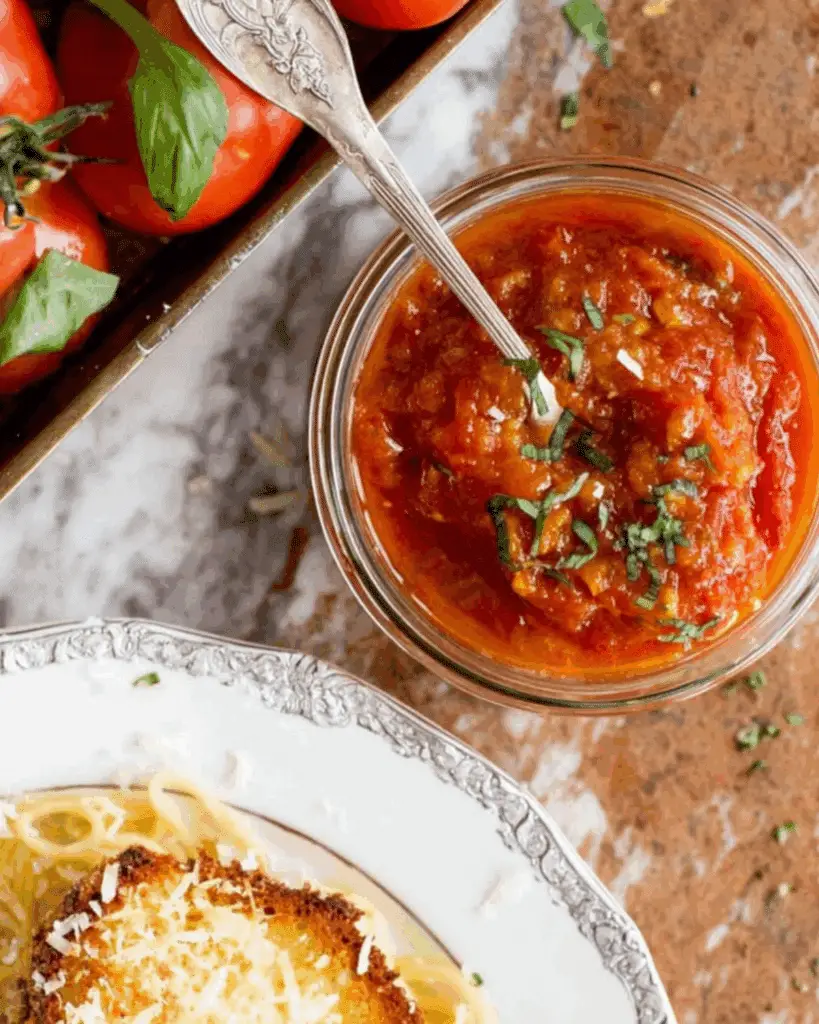
Frequently Asked Questions About Homemade Tomato Sauce
Can I Use Canned Tomatoes Instead of Fresh?
Yes. Canned whole tomatoes are an excellent substitute when fresh isn’t available. Just choose high-quality brands with no added sugar.
How Do I Prevent Tomato Sauce from Being Bitter?
Balance acidity with a pinch of sugar or a splash of balsamic vinegar. Simmering gently instead of boiling also prevents bitterness.
Should Tomato Sauce Be Covered or Uncovered While Simmering?
Leave the pot partially uncovered. This allows excess water to evaporate, creating a thicker, more concentrated sauce.
Conclusion: Bringing Homemade Flavor to Your Kitchen
Homemade tomato sauce is one of the simplest ways to elevate everyday meals. With the right tomatoes, a few aromatics, and some patience, you can create a sauce that’s healthier, richer, and more versatile than anything from the store. Whether you whip up a quick 20-minute version or a slow-simmered Sunday favorite, this kitchen staple will always bring warmth and flavor to your table. Discover great ideas like southern tomato pie if you want another tomato-rich recipe to try next.
PrintHomemade Tomato Sauce
A simple and fresh homemade tomato sauce recipe made with ripe tomatoes, olive oil, onion, garlic, and herbs. Perfect for pasta, pizza, or casseroles, this versatile sauce is healthier and more flavorful than store-bought versions.
- Prep Time: 15 minutes
- Cook Time: 40 minutes
- Total Time: 55 minutes
- Yield: 6 servings
- Category: Sauce
- Method: Simmering
- Cuisine: Italian
- Diet: Vegan
Ingredients
- 2–3 pounds fresh Roma or San Marzano tomatoes, peeled and chopped
- 2–3 tbsp extra virgin olive oil
- 1 medium onion, finely chopped
- 3–4 garlic cloves, minced
- Handful of fresh basil leaves
- 2 tbsp red wine or balsamic vinegar (optional)
- 1–2 tbsp tomato paste (optional, for depth)
- 1 tsp dried oregano
- Salt and black pepper, to taste
- Pinch of sugar (optional, to balance acidity)
Instructions
- Bring a large pot of water to a boil. Score a small ‘X’ on the bottom of each tomato and blanch them for 30–60 seconds until skins loosen. Transfer to an ice bath and peel.
- Heat olive oil in a large pan over medium heat. Add the chopped onion and sauté until translucent.
- Stir in the minced garlic and cook for about 1 minute, being careful not to burn it.
- Add peeled, chopped tomatoes and stir well. Mix in oregano, salt, and black pepper.
- Reduce heat and let the sauce simmer for 30–40 minutes, stirring occasionally. For a thicker sauce, simmer uncovered.
- For a smoother texture, blend with an immersion blender.
- Add fresh basil and a splash of red wine or balsamic vinegar toward the end of cooking. Adjust seasoning to taste.
- Serve hot over pasta, use as pizza sauce, or store for later.
Notes
- Use canned whole tomatoes if fresh ones are not available.
- Add a pinch of sugar if the sauce tastes too acidic.
- Simmer uncovered for a thicker sauce, or covered for a lighter consistency.
- Freeze in small portions for quick weeknight meals.
- For extra creaminess, stir in heavy cream or coconut milk at the end.
Nutrition
- Serving Size: 1/2 cup
- Calories: 90
- Sugar: 6g
- Sodium: 220mg
- Fat: 5g
- Saturated Fat: 0.7g
- Unsaturated Fat: 4g
- Trans Fat: 0g
- Carbohydrates: 10g
- Fiber: 3g
- Protein: 2g
- Cholesterol: 0mg

